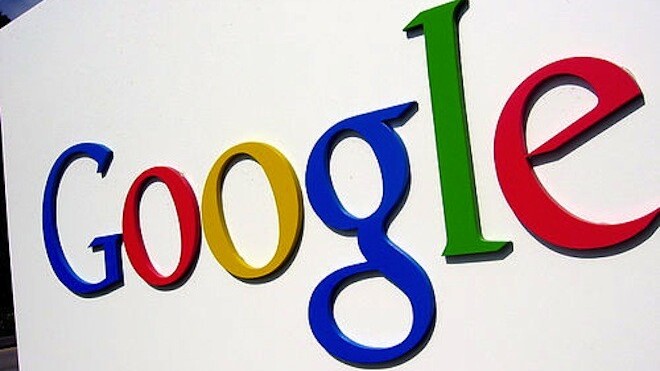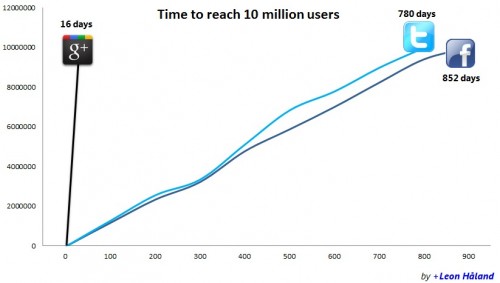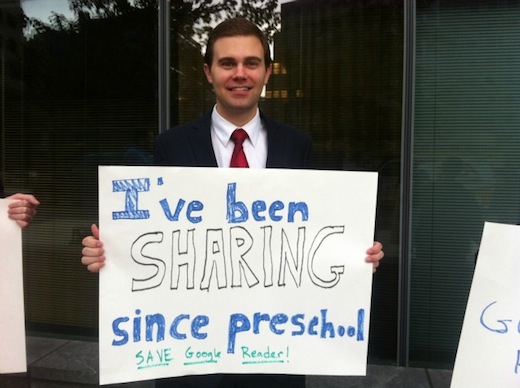
2011 was a year of many milestones for Google. The company launched several new products, revamped existing services, and it was also the year Google made its biggest acquisition ever.
Google saw several small but significant developments, changes and services. In January, with the Egyptian government pulling the plug on the nation’s Internet, Google launched Speak2Tweet, in cooperation with Twitter, making it possible for Egyptians to call in their tweets to report on events on the ground during the protests that toppled former Egyptian president, Hosny Mubarak.
In February, Google made changes to its search algorithm, affecting almost 12% of all queries. The change had a direct effect on content farms, stopping them from ranking high in Google’s search results.
In April, co-founder Larry Page replaced Eric Schmidt as CEO of the company. Schmidt took on the role of Executive Chairman, with Sergey Brin taking on the title of Co-Founder.
Google saw some pretty impressive statistics this year. In May, YouTube turned 6, hitting 3 billion views per day with a whopping two days worth of video uploaded every minute, while in October Google Earth hit the 1 billion download mark.
It’s been a busy year for Google and we’ve outlined some of the company’s biggest news below.
Google+ Launches to Mixed Reviews
Before we got to see Google+, we got a glimpse of Google’s plans for the social network through the launch of the Google +1 button in March. Three months later, Google launched a +1 button for the entire web. Intended to be used like Facebook likes, the +1 button makes it easy to make recommendations for your friends, but it doesn’t appear to be a popular sharing method. With the launch of the social network, many Google+ users removed the +1 tab from their profiles entirely.
Undoubtedly, the June 28th launch of Google+ was the tech giant’s biggest news of 2011, creating the most buzz for the company, whether positive or negative. It seemed people either loved or hated Google+ – there was no in between. Many were quick to jump on the ‘Google+ is dead’ bandwagon before the social network had even launched its public beta. We gave our thoughts on the matter here at The Next Web, but our outlook for Google+ was certainly a much more positive one.
After its launch, people were so eager to get into the private beta, invites were actually being sold for as much as $27 on eBay. Google+ brought some new features to the social network table that set it apart from its competitors, with Google+ Hangouts giving users the chance to take advantage of a group video chat feature among other things.
Sixteen days after launching Google+ passed the 10 million user mark, reaching the milestone far quicker than Facebook and Twitter.
The social network was quick to become the fastest website to reach 25 million users, growing at a rate of 1 million users per day at the time. The latest estimates put Google+ at over 62 million users, adding users at a rate of 625,000 per day.
Google+ was able to do all of this, while remaining in private beta. While the private beta might have outstayed its welcome by a little bit, Google+ finally opened its doors to the public in September, but before then, statistics did show that users weren’t necessarily making as many public posts as Google might have liked. In August, statistics showed that 48% of Google+ users had not made any public posts at all, which could also mean they had made no posts whatsoever.
The will-it, won’t-it angle on Google+ that has been beaten to death over the past six months wasn’t the only black spot on Google’s record. Launching with a policy which forced users to use their real names on the social network caused an uproar, particularly when Google suspended a large number of accounts using pseudonyms. It took a few months, but Google finally relaxed its real name policy, recognizing a legitimate need for online anonymity for some.
Google+ has slowly been unrolling new features over the past 6 months, including launching Google+ Pages, yet another tool in its arsenal which could pose a threat to its competitors. Other new features we’ve seen over the past period have included noise control for your streams and better integration with Gmail and Contacts.
While Twitter certainly has cornered the market on celeb use of social media, Google+ has its fair share of celebrities, politicians and sports players who have joined the network. Britney Spears is the most followed user on Google+, and recently shot right past the 1 million circle mark. Other celebs hot on her heels in the top 10 include Snoop Dogg, Tyra Banks and Richard Branson. So far only one other Google+ user has been circled over 1 million times, but it’s not a celebrity. Instead it’s Google’s own CEO, Larry Page.
Google+ also made the headlines when US President Barack Obama joined the network, but he’s only been added to just over 8,000 circles, while Google+ Hangouts caught people’s attention, with everyone from the Dalai Lama and Archbishop Desmond Tutu to US presidential candidates hanging out on Google+.
While Google+ may have its detractors, it has gained a loyal following from several communities, most significantly with great backing from the online photography community. Google+ could also prove to be a great tool for journalists, an excellent project management tool, or even a photography portfolio.
With the success of Google+, Google’s earlier foray into the world of social networking came to a timely end in October. Google finally made the move to shut down Buzz, a short-lived Twitter clone which lasted close to two years, but barely made a dent in the social media scene.
The Google Revamp
With the launch of Google+, Google has launched an extensive revamp of all of its products, bringing tighter Google+ integration to most of its products, and bringing in a more consistent and sleek look for each site.
YouTube
We caught a glimpse of the YouTube redesign back in July, with changes including better subscription management, better video recommendations, and of course more direct integration with Google+. The redesign officially launched in December, but it clearly did not go down well with YouTube users. The video announcing the launch received just over 4,000 likes, in stark contract with over 15,000 dislikes.
In December, YouTube saw yet another update, but this time to the backend, with changes being made to the YouTube Video Manager, and most recently YouTube has announced plans to implement a more targeted form of advertising, tailoring ads for each user.
Gmail
In October, Gmail got a major redesign, which we also caught an early glimpse of in July. The redesign not only gave users a sleeker and cleaner experience, the new changes aimed to adapt Gmail to your personal preferences, depending on whether you want to give more screen real estate to Gmail chat or labels, as well as being able to adjust readability to fit your screen size.
In December more changes came to Gmail, this time in the form of more integration with Google+. With the latest features, users are now able to see their contacts’ latest Google+ updates in Gmail, and can also see which circles they’ve added their contacts to.
While the Gmail changes were received with more enthusiasm than the YouTube changes, Google’s video below still shows a significant amount of discontent, with 34,000 likes up against almost 30,000 dislikes.
Google Reader
Google’s move to make major changes to Google Reader is another step that was met with quite a bit of opposition. Not only was the RSS reader redesigned in keeping with the new Gmail look, certain social features were dropped, no doubt, in an attempt to push users over to Google+.
While users can now share stories directly from Google Reader to Google+, they lost the ability to share items they were reading with their friends and followers within the RSS reader itself. The change prompted a 10-man protest outside Google’s Washington DC headquarters.
On a more serious note, the changes had an adverse effect on Google’s Iranian users. Google Reader is one of the few sites with social networking features that was not blocked in Iran, and by removing the sharing features, Google instantly took away one of the few methods available to Iranian activists for disseminating information, as is mentioned in many of the comments on this Google Plus post.
Google Documents and Search
This year, when you thought it couldn’t possibly get any simpler, the Google Search page was stripped down a little more, getting rid of the I’m Feeling Lucky Button, and bringing the page in line with the rest of the Google product looks. Google Documents saw a similar change in August.
One of the most recent design changes we’ve seen on Google was a little bit of fine-tuning, with the redesign of the black bar which graced pretty much any Google page you were on.
Google Acquisitions
Google made 26 acquisitions this year, the biggest of which was the Motorola acquisition, although it is yet to be concluded. Another significant acquisition was seen a few months later when Google bought Zagat. Other interesting buys have included acquisitions of voice SayNow, social movie review site Fflick for $10 million, UK price comparison site, BeatThatQuote.com for $58 million and German group buying site, DailyDeal for $114 million. Google’s most recent acquisition, which was announced on December 13, was dining recommendation app Alfred.
Google Acquires Motorola Mobility
2011 has been a big year for Android, but no one piece of news was bigger for the operating system than Google’s planned acquisition of Motorola Mobility in August, with a price tag of $12.5 billion. It was later revealed that the search giant outbid itself by 33% to make the purchase. The acquisition is Google’s real chance to position itself as a smartphone vendor, and has the potential to offer users a more centralized Android experience, something which continues to plague the OS.
The acquisition, however, has yet to be finalized. The European Commission is investigating the deal, and was meant to make a decision by 10 January 2012, although now more delays have been anticipated, as more information has been requested from Google. Google is optimistic about the acquisition, and a Google spokesperson told Bloomberg that it was “confident the commission will conclude that this acquisition is good for competition.”
So what exactly is Google getting with Motorola acquisition? For one thing, it means that Google can get its hands on over 17,000 patents. Additionally, Google will also have the ability to produce far more official Google phones, using Motorola’s technology, which could also ensure a more unified Google experience across devices. In addition to the obvious access to Motorola’s mobile technology, Google is also gaining access to a set-top box manufacture, perfect for Google TV, and of course the patents.
At the same time, it’s not all good news for Google in terms of the acquisition. Along with patents, devices and hardware, it’s also taking on Motorola’s lawsuits, with Apple suing the company in Germany, along with a few other existing suits.
Google Acquires Zagat
Another big 2011 acquisition for Google was its September purchase of Zagat. Founded in 1979, Zagat has long been considered the leading authority on where to dine thanks to its team of over 350,000 site surveyors. Up for sale since 2009, Google swept in and made the buy for around $125 million.
With this acquisition, Google now has access not only to the Zagat brand, but to all of its data, which is bound to come in handy with Google Places.
Android Numbers
At the beginning of the year, Android made a significant achievement, surpassing Symbian as the world’s dominant smartphone OS. Taking a look at some more recent statistics, we find that Android is still leading the smartphone crowd, with an 11% share, followed by iOS and Symbian at 5% each. To put this in context however, it’s worth noting that smartphones account only for 27% of the world’s phones.
The operating system itself has seen several milestones over the year, the most recent of which puts the number of daily activations at 700,000 handsets. As we’ve pointed out before, activations don’t necessarily represent new customers, as the figure also includes upgrades.
That said, taking a look at the figures over the past year Android’s growth has been impressive. In August 2010, Android was seeing only 200,000 activations per day, less than a year later, by June of this year, it had increased by 150% to 500,000.
By July 2011, Android was seeing 550,000 activations per day on 130 million devices, with 6 billion downloads to date from the Android app market.
In October 2011 the number of activated handsets had gone up to 190 million, and in December, the number of downloaded apps had shot up to 10 billion.
It wasn’t until Christmas that Android’s figures saw an unprecedented surge, with 3.7 million activations over the Christmas weekend alone.
Ice Cream Sandwich
Announced in October 2011, Ice Cream Sandwich is the much-anticipated follow-up to the earlier version of Android, Gingerbread. The new OS will bring Android tablet Honeycomb features to users’ smartphones. You can find out more about Ice Cream Sandwich’s specs and what to expect from the new version of the OS here.
Initially, Ice Cream Sandwich won’t be available to all handset users. The Samsung Galaxy Nexus will ship with Ice Cream Sandwich, as will Sony Ericsson’s 2011 Xperia line. While the Galaxy Nexus’ launch was originally slated for November 2011, just last week, Google announced that it had been delayed until the first quarter of 2012.
With a few glimpses of Ice Cream Sandwich in the wild, Google has also already released the source code for Ice Cream Sandwich (aka Android 4.0).
However, long before its launch, developers have already been quick to point out the latest version’s many flaws.
Google Wallet
In May, we were given a sneak peak of Google Wallet, using NFC technology to turn your phone into a virtual wallet. In September the service went live for Google Nexus 4G users on Sprint in major American cities including New York, San Francisco, Los Angeles, Chicago and Washington DC. The service is also available to Citi, Mastercard, Visa, Discover and American Express card holders.
In an attempt to keep the service as secure as possible, all of your card information will be stored in a single place on a chip, and a a limit of $100 is placed on all new cards, until the owner releases the limitation.
The video below gives an impression of just how easy-to-use Google Wallet could be:
Carrier IQ
Android suffered from its share of threats throughout 2011, the most recent of which probably created the most buzz. The discovery that Carrier IQ could be on users’ Android handsets caused quite the scare, with Carrier IQ, an analytical software that has been found to analyse device diagnostics to identify and assist carrier engineers with dropped calls and failed SMS messages, hit the headlines after it was reported that the software stored SMS messages, visited websites and email contents – prompting class action lawsuits and investigation by European regulators detection apps topping 200,000 downloads in the first 3 days.
So why did Carrier IQ cause such a big scare? While analysing device diagnostics to identify and assist carrier engineers with dropped calls and failed SMS messages, the software is said to have also stored SMS messages, browsing history and email contents, leading to class action lawsuits and investigation by European regulators.
Music
Another new product that game out of Google this year was Google Music, but it launched to a US-only audience. While still in private beta, over 1 million users tested the service, streaming an average of 2.5 hours of music per day – that’s 2.5 million hours of music being streamed, per day.
Google announced a partnership with over 1,000 producers including EMI, Universal, Sony Music Entertainment, and a ton of indie labels. The service provides users access to over 13 million tracks, while Google also announced plans to host exclusive concerts for major bands including The Rolling Stones and Coldplay. Aside from some awesome concerts, Google also debuted Busta Rhymes latest album.
In November, Google Music opened up to the public, in the US that is, with the Android app available as a free download. With the app, users can listen to songs they’ve uploaded to Google Music, can purchase new songs, and of course it makes it easy to share what you’re listening to with your friends. Like with all of its other products, Google was quick to offer Google+ integration, allowing users to easily share songs or albums they’ve purchased with their Google+ followers.
But it wasn’t just users living outside of the US who didn’t get to jump on the Google Music bandwagon. In fact, over 26 million Android users were left out in the cold since Google Music is compatible only with Android 2.2 and above, meaning that about 13% of Android users at the time did not have access to the public service.
Google Search
Every year, Google gives a little bit of insight into what its users have been searching for with its annual Google Zeitgeist. The video Google put together was quite breathtaking, while taking a closer look at the data revealed that users are looking for local news, as was revealed by statistics in the US, UK and the Middle East.
To see a complete list of Google’s achievements in 2011, check out its list here.
You can find the entire Tech Rewind 2011 series collected here.
Get the TNW newsletter
Get the most important tech news in your inbox each week.








